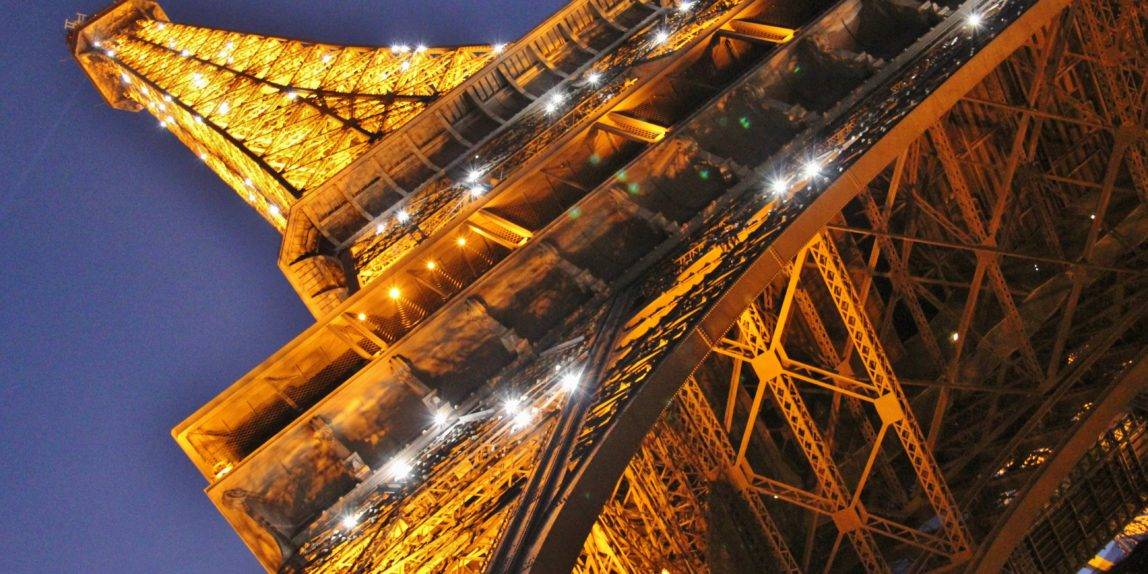Our Month in Paris Begins!
We climbed the stairs out of the Strasbourg-Saint-Denis metro station to come above ground in the middle of Paris, face-to-face with Porte Saint-Denis, the gate where the kings of France would pass to enter Paris coming from the Saint-Denis Basilica. It was inspired by the Arch of Titus in Rome and designed in 1672 by the architect Francois Blondel. You’ll notice that the smaller arches on either side of the main arch, which served as pedestrian passages, have now been closed off.
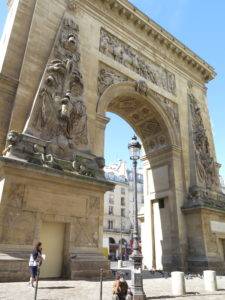
![]()
![]() The inscription at the top reads LUDOVICO MAGNO, “To Louis the Great”, in gilded bronze. Above the arch’s southern facade is a horizontal bas-relief of sculptor Michel Anguier’s “The Passage of the Rhine”, and on the other side is a depiction of the siege of Maastrict. At the base of the southern walls are sculptural emblems of victory: a woman in despair (representing Holland and the Rhine), a lion with a sword beneath his paw, a triumphant king.
The inscription at the top reads LUDOVICO MAGNO, “To Louis the Great”, in gilded bronze. Above the arch’s southern facade is a horizontal bas-relief of sculptor Michel Anguier’s “The Passage of the Rhine”, and on the other side is a depiction of the siege of Maastrict. At the base of the southern walls are sculptural emblems of victory: a woman in despair (representing Holland and the Rhine), a lion with a sword beneath his paw, a triumphant king.
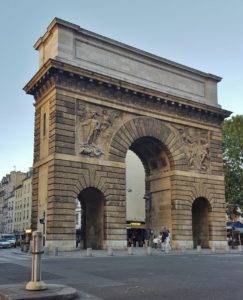
A 5-minute walk down the road along Boulevard Saint Denis will lead you to Porte Saint-Martin, constructed in 1874. Its architect, Pierre Bullet, was a former student of Porte Saint-Denis’ Franà§ois Blondel. Its inscription in Latin at the southern facade reads “To Louis the Great, for having vanquished the German, Spanish, and Dutch armies: the Dean of the Guild and the Aldermen of Paris.” This limestone and marble arch is rusticated, its rough surface making it visually heavier in comparison to Porte Saint-Denis.
At the northern facade are bas reliefs of Pierre Legros’ “The Capture of Limbourg”, represented by a woman sitting beside a lion, and Gaspard Marsy’s allegory of the defeat of the Germans. The southern side depicts a partly nude Louis XVI as Hercules and the capture of Besanà§on.
It’s interesting to note that the Porte Saint-Denis was the inspiration for the Arc de Triomphe which was finished in 1836, and later for New York’s Manhattan Bridge Arch, completed in 1909.
A couple of blocks from here, we found our home for the next month, and as promised, Jocelyn was waiting there to hand us the keys. We have an entire month of free accommodation here, arranged through our membership in Intervac Home Exchange. Our flat is in a building hundreds of years old with wooden stairs worn down over the centuries to be smooth and sloped. The apartment we discovered two floors up this fantastic stairway, was filled with art, antiques and music and our hosts had left us a lot of information for our vacation, as well as some food and wine to start us off with.
After a short walk around the neighbourhood we had some wine, bread, cheese and prosciutto to finish off our first evening in Paris.
Our New Metro Pass
We started out walking yesterday, following a route towards the Louvre, recommended by our Intervac home exchange host that would take us past a nice variety of various little shops and cafés. It was nice just being out and about, reacquainting ourselves with the Paris we fell in love with four years ago.
Our first stop was at the Louvre metro station in Les Halles. After much online research, we decided to buy the Navigo mois decouverte Pass. For 73 Euros, plus 5 Euros for the card, you can travel for the full calendar month across all of Paris, zones 1 to 5, plus out to Versailles, Charles deGaul airport, and even Disneyland Paris should you be so inclined. And that includes travel by bus, Metro and the RER trains. You also need some photos made, another 5 Euros, and there are photo booths near most of the major metro ticket booths just for that purpose. And the photo booth can even be directed to speak instructions to you in English. Sort of.
So after 20 minutes of dealing with a slightly uncooperative photo booth, we approached the ticket booth and in my best French I requested “duh naveego mwah daycoovairtay” and handed him our photos. Remarkably, he understood me and went about putting the things together for us. We were able to pay with Visa and he gave us our new photo IDs in a plastic case that we could now wave towards the ticket taking thingy and get on just about any transportation we desired.
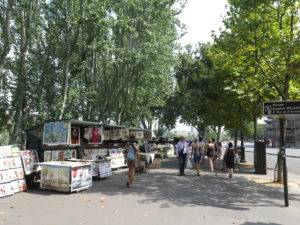
From there we started out for a long walk, past the Louvre, through the Jardin de Tuileries, along the west and east banks of la Seine, and finally into the Latin Quarter, ending up at Le Latin restaurant for lunch. For 15 Euros I had a pretty good 3-course meal of Soupe à l’oignon gratinée, Lupin a la moutarde, and Creme Brûlée for dessert. Chris chose salad with goat cheese, a vegetarian ratatouille, and the same dessert. We ate at a little table on the edge of the open side, facing the street/walkway. Hundreds of little restaurants are all crammed together here with the chairs and tables spilling out into the street. Delivery trucks and cars occasionally brave the narrow alley, crawling through while the odd table must be shifted for the vehicle to scrape by against a patron’s chair!
Our meals also included a complimentary small glass of a nice Rosé and we completed our meal with espresso. The total bill was less than 38 Euros.
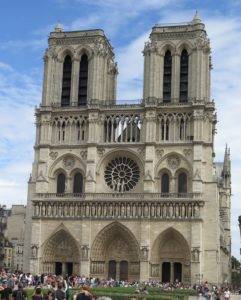
After lunch we continued our walk, crossing over two bridges across the Ile de Cité and past the Notre-Dame cathedral before using our new Navigo mois decouverte cards to hop aboard a metro back to home. We headed out again for some groceries at the Mono Prix around the corner, but we were still stuffed from lunch so made only salad for a late dinner before bed.
Today we wandered around our neighbourhood, discovering hundreds of ethnic restaurants, exploring the fashion district, and what appears to be a bit of a red-light district near us, then headed out further to see Canal St-Martin. The Canal Saint-Martin is a 4.5 km long canal connecting the Canal de l’Ourcq to the river Seine. Mostly large tour boats carry tourists through a series of Locks on a 2.5 hour cruise. Much of the canal is surrounded by a strip of park providing a beautiful area to walk in the shade, find a bench to rest, or lawns to stretch out and sun tan, or just watch the Locks at work.
Unless you want to pop out to shop as soon as you wake up in the morning, you may want to stop in at one of the boulangeries (bakeries) before heading home, for some fresh croissants for breakfast, and maybe choose a boucherie (butcher/meat market) on your way home in the afternoon to buy a freshly roasted chicken for dinner.
Monmartre and Museums
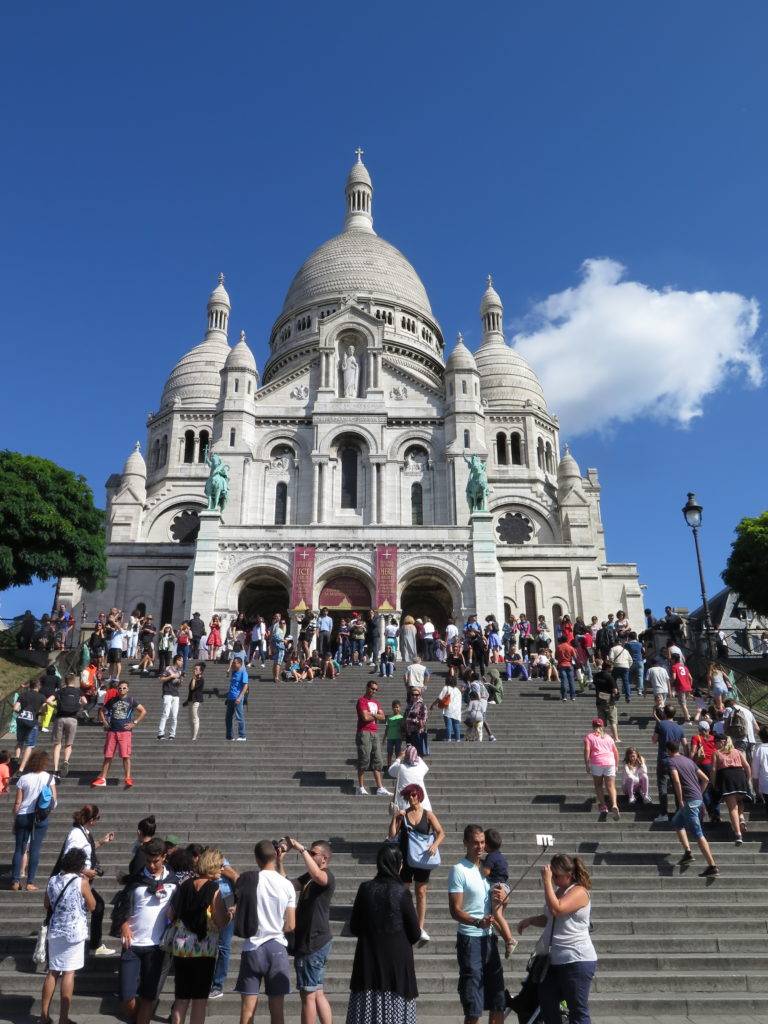
One of my favourite districts in Paris is Montmartre. Primarily known for its artistic history, the white-domed Basilica of the Sacré-Coeur on the summit, and as a nightclub district, including La Chat Noir and the Moulin Rouge. Near the end of the 19th century, many artists had studios or worked in or around Montmartre, including Amedeo Modigliani, Claude Monet, Pierre-Auguste Renoir, Henri de Toulouse-Lautrec, Suzanne Valadon, Pablo Picasso, and Vincent Van Gogh.
Today it is still a bustling, thriving area filled with cafés, galleries, and artists roaming the squares either trying to sell their work or offering to draw your portrait. We started our day early, taking the Metro to near the bottom of Montmartre. You can either climb the MANY steps up towards the Basilica, or take the funicular, which is what we chose today.
We took our time, roaming through the narrow cobble-stoned streets soaking up the atmosphere, and watching our bags for pick-pockets, a hazard in any crowded tourist area in Paris. We made our way to the Musée de Montmartre at 12 rue Cortot. This is a large home and garden turned into a museum, and former home of a variety of artists including Suzanne Valadon and Augusta Renoir (one of my favourites).
It’s an interesting museum, the studio space has been accurately recreated from old photos and notes, and has a VERY real feel of the original studio. Various paintings on exhibit have recognizable settings in the garden.
After the museum we wandered back out into Montmartre’s main square which was now PACKED with tourists. We watched for people to leave a restaurant and luckily grabbed seats at a small table on the outside edge of a café, La Bohéme du Tertre. There were lots of empty tables inside but NOBODY wants to eat inside anywhere in Paris. We had a wonderfully efficient and friendly waitress named Jennifer and enjoyed the Plat du Jour, chicken and fish brochettes.
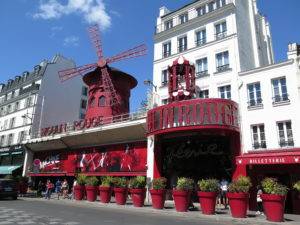
After lunch we wandered down the Montmartre hill, through the winding streets, past La Chat Noir and Moulin Rouge, and found our way to the Musée National Gustave Moreau. Gustave Moreau was a major figure in French Symbolist painting, mainly biblical and mythological figures. Every inch of his home and studio are filled with his work and even though he is not one of my favourites, his talent was impressive and the volume of work was incredible.
Château de Fontainebleau
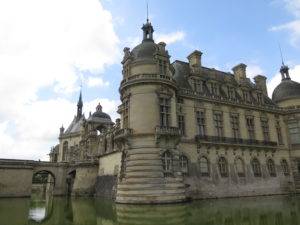
The town of Fontainebleau can be reached from Paris taking the train from Gare de Lyon station. Exiting the station on arrival, we had to wander about a bit before finding the nearby bus stops. Bus number 1 or 34 leaves frequently and goes by the château in just a few minutes. The château and the grounds are beautiful and well worth a visit.The first references to the Château de Fontainebleau date back to the 12th century. Since then, all the kings of France have lived in the palace, and have continuously enlarged and embellished it. It is a unique example of a royal residence, loved and cherished for over eight centuries.
The Apartments of the sovereigns evoke all the pomp and splendour of the French court; antechamber, drawing rooms, ceremonial rooms, the Council Room and the Throne Room all paint a vivid picture of the life of the monarchy. The carved woodwork, paintings, tapestries and furnishings provide evidence of the Apartments occupancy from the 16th to the 19th century.Refurbishment of Napoleon I’s interior apartments began in 1804. Comprised of a series of rooms for the Emperor’s private use (bedchamber, office, private drawing room, bathroom, aide-de-camp’s common room and antechamber).
The château was one of the major artistic centres of 16th-century Europe. The Renaissance Rooms, unique in France, have retained their stunning fresco and stucco décor created by the Italian artists Rossi and Primaticcio under the reigns of Francois l and Henry ll.
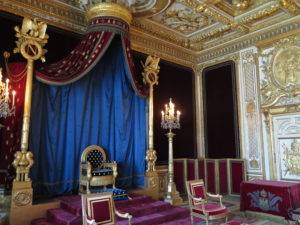
Located on the ground floor of the château, the private Apartments complete the changes made for Napoleon I, who wanted two private adjoining apartments, one for himself, and the other for Josephine (later occupied by Marie-Louise). There are also rooms that were reserved for the use of the Emperor’s close advisors and the Stag Gallery.Opened in 1986, several rooms display historical memorabilia relating to Napoleon 1 and his family during the Empire (1804-1814). The Emperor as the official and the man, his second wife Marie-Louise, his son, the King of Rome, his mother and his brothers and sisters are all recalled in their portraits and belongings.
This set of four drawing rooms was laid out in 1863 for Napoleon III’s wife, Empress Eugenie. Designed for relaxing and hosting private receptions for the court, these rooms are where the Empress displayed her remarkable collection of oriental art from the Far East, China and Siam, in the fashion of that time.(Chateau descriptions from Paris museum pass website)
Picasso Museum and Musée d’art et d’histoire du Judaïsm
Pablo Picasso (25 October 1881 – 8 April 1973) was a Spanish painter, sculptor, printmaker, ceramicist, stage designer, poet and playwright who spent most of his adult life in France. Regarded as one of the most influential artists of the 20th century, he is known for co-founding the Cubist movement, the invention of constructed sculpture, the co-invention of collage, and for the wide variety of styles that he helped develop and explore. Among his most famous works are the photo-Cubist Les Demoiselles d’Avignon (1907), and Guernica (1937), a dramatic portrayal of the bombing of Guernica by the German and Italian airforces.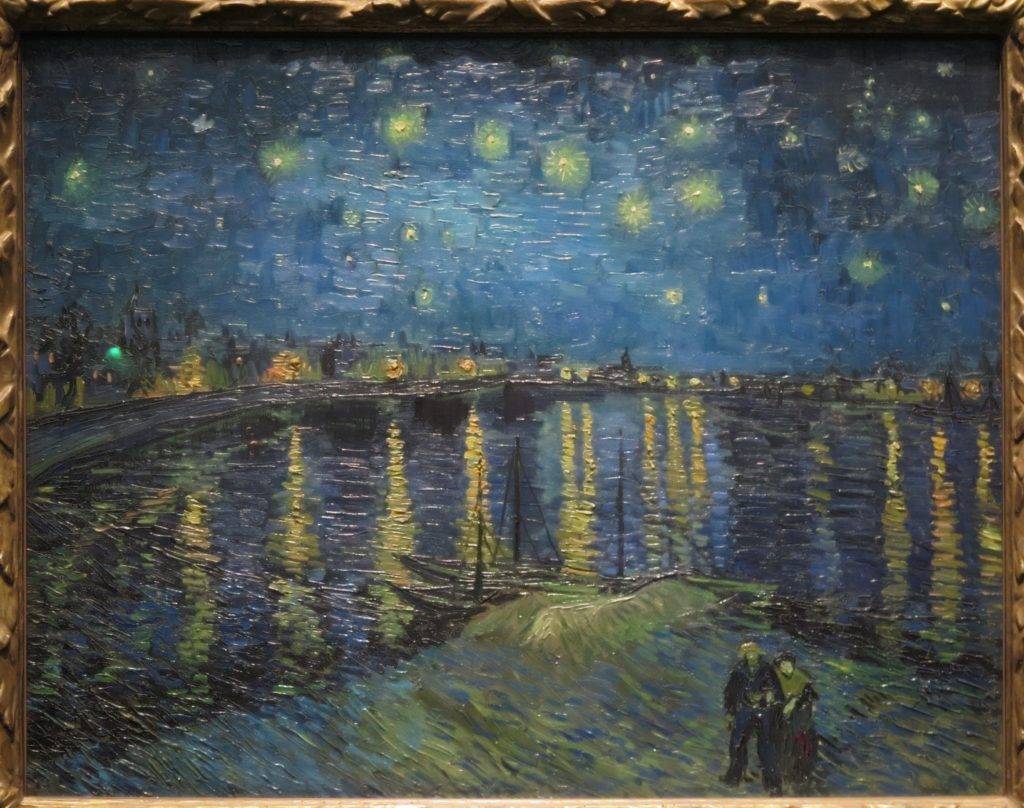
The Musée Picasso is an art gallery located in the Hôtel Salé in rue de Thorigny, in the Maria’s district of Paris, dedicated to the work of Pablo Picasso. In 1968, France created a law that permitted heirs to pay inheritance taxes with works of art instead of money, as long as the art is considered an important contribution to the French cultural heritage. This is known as a dation, and it is allowable only in exceptional circumstances. Domonique Bozo, a curator of national museums, selected those works that were to become the dation Picasso. This selection was reviewed by Jean Leymarie and ratified in 1979.
It contained work by Picasso in all techniques and from all periods, and is especially rare in terms of its excellent collection of sculptures. Upon Jacqueline Picasso’s death in 1986, her daughter offered to pay inheritance taxes by a new dation. The collection has also acquired a number of works through purchases and gifts.Picasso once said “I am the greatest collector of Picassos in the world.” He had amassed an enormous collection of his own work by the time of his death in 1973, ranging from sketchbooks to finished masterpieces.
The Musée Picasso has over 5,000 works of art by Picasso including 3,700 works on paper, ceramics, sculptures in wood and metal, and paintings. This is complemented by Picasso’s own personal art collection of works by other artists, including Cézanne, Degas, Rousseau, Seurat, de Chirico and Matisse. It also contains some Iberian bronzes and a good collection of African art, by which Picasso was greatly inspired. The museum also contains a large number of works that Picasso painted after his seventieth birthday.
From the Picasso museum, it was just a short walk through a largely Jewish ethnic district to the Museum of Jewish Art and History. The Museum is housed in one of the most beautiful historic monuments in the Marais, the Hôtel de Saint-Aignan, built in the 17th century. The museum traces the evolution of the Jewish world via its artistic and cultural heritage, focussing on the history of the Jews in France since the Middle Ages and evoking the communities of Europe and North Africa. Its collection, one of the finest in the world, comprises religious objects, manuscripts, textiles and unique archive documents concerning the Dreyfus Affair. Special importance is given to the Jewish presence in the arts, featuring the painters of the School of Paris (Chagall, Kikoïne, Soutine…) and contemporary artists such Christian Boltanski and Sophie Calle.
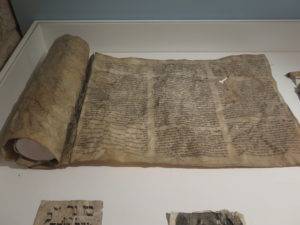 One thing we learned is about burying the contents of a “Genizah”. When sacred documents fall out of use, are worn out beyond practical use, or are in some way partially destroyed, they must be preserved, not destroyed. Most synagogues have a room for this but this space is often regularly cleared out and the contents buried. Many of the items on display in this museum were found in an ancient genizah.
One thing we learned is about burying the contents of a “Genizah”. When sacred documents fall out of use, are worn out beyond practical use, or are in some way partially destroyed, they must be preserved, not destroyed. Most synagogues have a room for this but this space is often regularly cleared out and the contents buried. Many of the items on display in this museum were found in an ancient genizah.
The Louvre and l’Orangerie
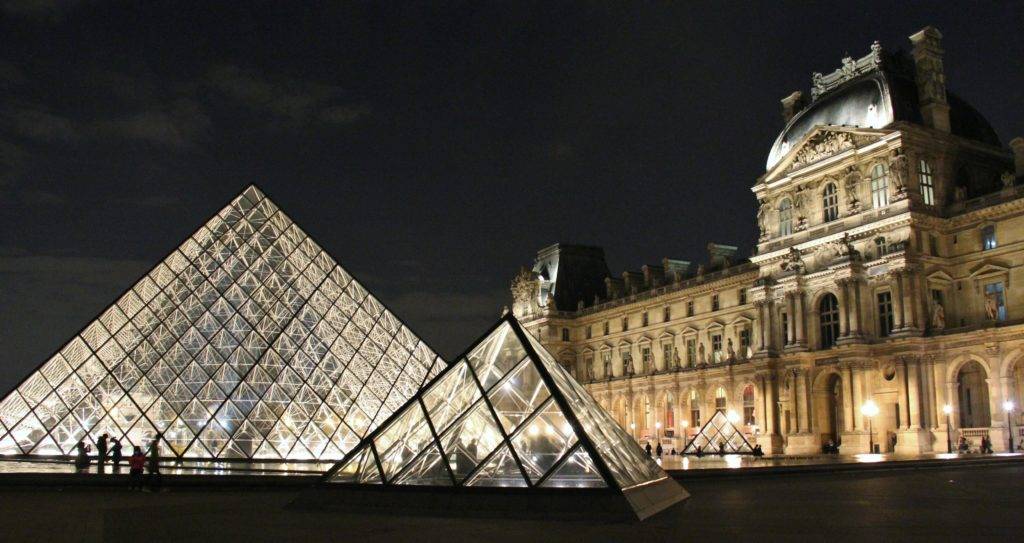
The Louvre is the world’s largest museum, originally built as a fortress in 1190, covering an area of 652,300 square feet! It was renovated to become the Royal Palace in the 16th century but when Louis XlV moved out to Versailles in 1793, the Louvre became a museum.
The main entrance to the Louvre always has a MILE long lineup first thing in the morning, and most of the day too. There is another entrance we read about (Porte des Lions) where the lineups tend to be MUCH shorter, but couldn’t quite figure out where it was. So we headed over to the main entry by the giant glass pyramid. Luckily our Museum Passes got us past most of the lineup and we were in the door in about 15 or 20 minutes.
The Louvre is HUGE and can be quite intimidating, especially for a first-timer. Luckily we knew where the bathrooms were for a quick pit stop, as they are few and far between after this. We also grabbed one of the museum floor plans from an information desk and headed out for the level 2 of the Richelieu wing for Northern European paintings. Some very nice HUGE paintings, religious, wars, portraits, nudes.
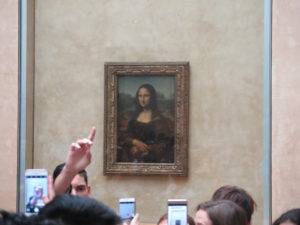
Level 1 of the Denon wing houses the Spanish and Italian paintings, including the Mona Lisa. This wing was BUSY and the crowds were HUGE as we approached the Mona Lisa room. For a close-up view, you need to gradually push your way into and along with the crowd of people to work my way up to right in front for a quick view and photo. Or, you can hang back and easily view the Mona Lisa over the crowd from about a 100 foot distance.
Unfortunately, the French painting wing was closed for renovations. We wandered through the Sculptures on 0 level as we made our way out of the building and into a small park with benches to have our lunch.
Parks and squares throughout Paris are full of benches and the locals all pack a lunch, with a bottle of wine, to eat outdoors and people watch and we love it too.
We were happy to get away from the crowds for a while and wander through the Tuileries gardens as we made our way towards the Musée de l’Orangerie. A carnival was set up all along one side of the Tuileries gardens so we walked through there on our way.
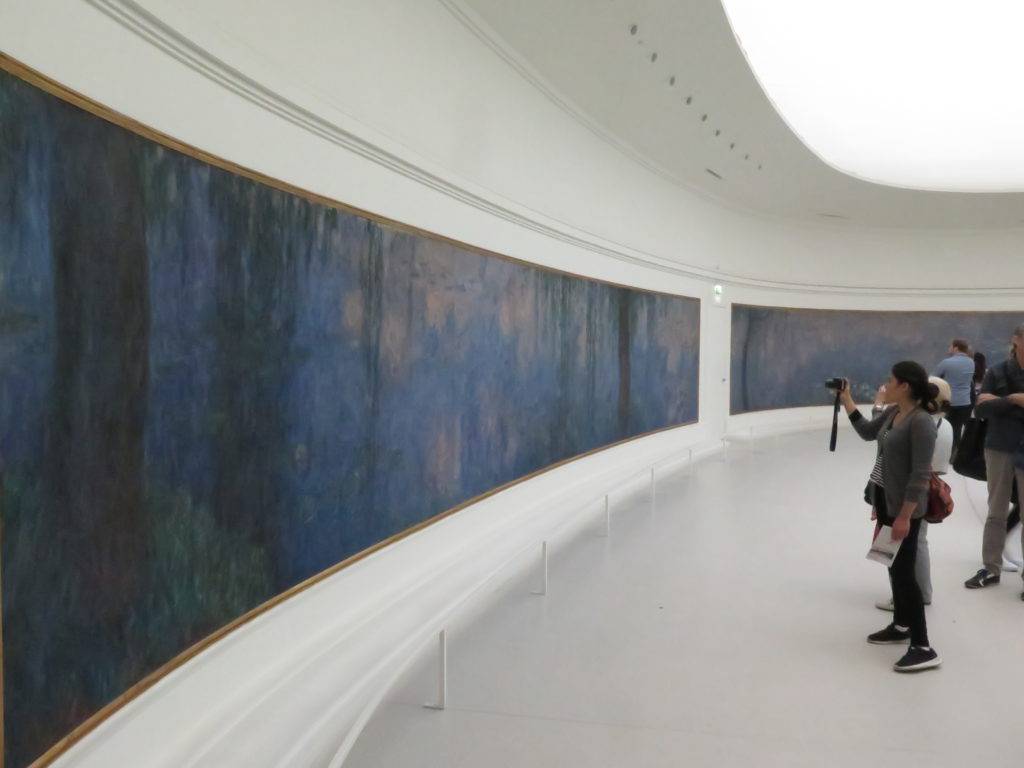
Once again our Museum Pass got us in for “free”. This is one of my favourite museums as I love Monet. He actually designed the vestibule, one whole floor actually divided into two rooms, JUST to hold his Water Lilies! He worked on them from 1914 until his death in 1926, taking inspiration from his water garden at Giverny. Displayed under diffused natural light, the eight paintings completely fill the walls from floor to ceiling in two large oval rooms.
Also housed within l’Orangie are paintings from Renoir, Cézanne, Matisse, Picasso and many others, and we wandered through them for another hour or so before reluctantly leaving for home.
There are numerous small grocers, fruit and vegetable markets, butchers and bakeries in our neighbourhood. So like the Parisians, we shop a little bit every day or two and enjoy fresh food all the time. So after climbing up above ground out of the Metro station, we made our usual stops a couple blocks from home then carried our produce (and wine) home for supper.
Château de Chantilly
Chantilly is outside of Paris zone 5 so our Navigo did not cover the train fare, but it cost only 8.70€ each way from the Gare de Nord station. Our museum Pass did cover the entrance fee to explore the château, stables and roam the very extensive gardens and forested pathways.
When you arrive at Chantilly, the bus stop is about 50 yards down the street to the left as you exit the train station. It’s a short, free ride through the small town and to the stop at the main entrance to the château.
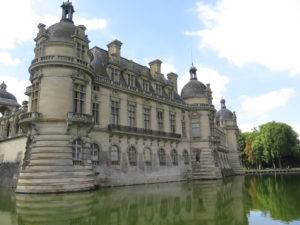
The Château de Chantilly is surrounded by water, gardens and a mix of statues and monuments. It was constructed between the 14th and 19th century for the Orgemont, Montmorency, Bourbon-Condé, and Orléans families. Razed to the ground during the Revolution, it was rebuilt between 1875 and 1885 by Honoré Daumet, primarily to house the art collections of Henri d’Orléans, duc d’Aumale and the son of Louis-Phillipe.
We were able to view 29 rooms, including the Condé Princes’ Large Suites, the Art Galleries and the chapel, although another 10 rooms, the duc and duchesse d’Aumale’s quarters, are available to see by guided tours only.
As with any of the various royal residence châteaus, the decor was OVER THE TOP! The art collection was extensive and included everything from Egyptian and Graeco-Roman statuettes, enamels and miniatures, exquisite HUGE tapestries, to paintings by Raphaël, Delacroix, Van Dyck, and a dozen other famous painters of the day.
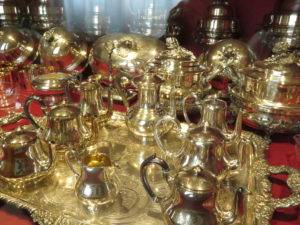
Even the “Gallery of Offices”, situated between the kitchens and the dining room was amazing, filled with gold flatware and silverware, porcelain, candelabras, silver and gold tea services, etc.
The Grand Stables are alongside a race track and by every outward appearance is more of an 18th century Grand Palace than a stable! We were able to see a few show horses inside and tour through the museum rooms.
The forested park surrounding the more formal Château gardens is full of walking paths, a small rustic Hamlet of 5 cottages, dozens of little clearings with statues or monuments, and ……. kangaroos!
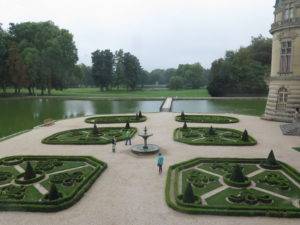
The gardens, as usual, were filled with benches for relaxing and enjoying lunch out of doors which we did, before continuing on to the Grand Stables and walking back to the train station. Although there is a sign at the stables pointing the way along a path with a 20 minute walk back to the station, there are no further signs beyond that. Luckily I have a European SIM card in my phone, bought in advance of our trip, so I’m able to use Google Maps cheaply and frequently, which saved the day once again! So after an hour or so, we did find the train station again and headed back home to Paris.
Arc de Triomphe and Musée d’Orsay
Today is the 6th and last day of our Musem Pass. We started out early to try and start ahead of the tourist crowds. Take the #1 metro to the Charles de Gaulle-Étoile stop and you will come up directly across the traffic circle from the Arc de Triomphe in Place Charles De Gaulle, at the top end of the Champs Élysées. From here you need to work your way across some of the ELEVEN streets that end here, until you find steps back underground to cross the traffic circle to come up directly below the Arc de Triomphe.
Although we arrived right at the 10:00AM opening time, there was already a long lineup, which we were able to bypass with our Museum Pass and go straight inside. Built in 1836, its primary purpose was to glorify the armies of the Republic and the Empire. On the ground level, below the arch, the Unknown Soldier was buried in 1921 and a permanent flame of remembrance was lit, still burning there today.
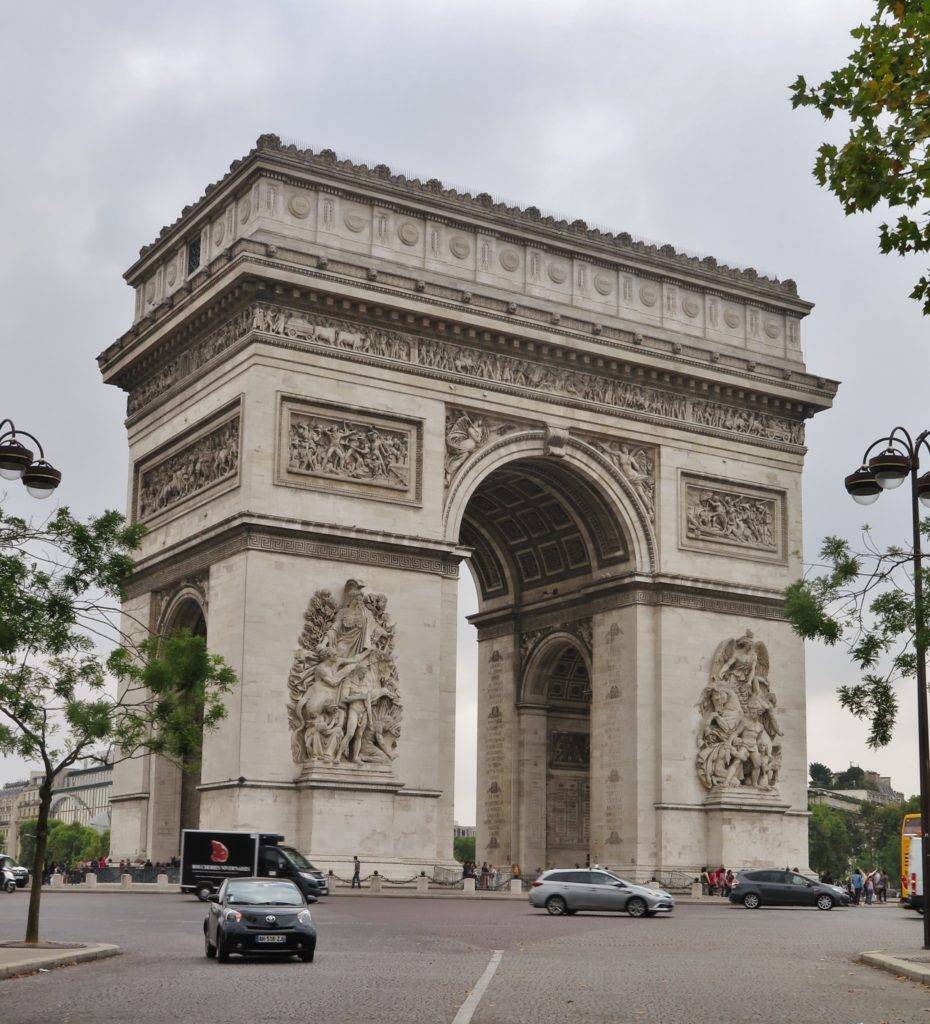
The Arc de Triomphe is covered with sculptures depicting soldiers and the Spirit of Liberty. Names of soldiers during the Revolution are engraved on tablets on the inside walls and a variety of inscriptions commemorate other events. But, the major tourism feature is the view from the mezzanine at the top of the 50M high monument. And the only way to get there is to climb up the circular stairway of 284 steps!
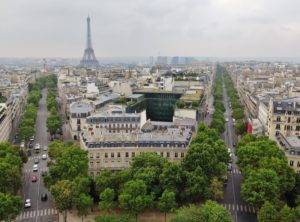
The view from the top is spectacular, and you can walk around the perimeter on the roof to see all of Paris for 360 degrees. Even though the day was cloudy, the view was well worth the climb.
After descending the 284 steps to leave, and retracing our underground path below the traffic circle, we took the metro back a few stops near the Luxor Obelisk at Place de la Concord at the end of the Tuileries gardens. This ancient Egyptian granite obelisk is originally from Luxor, has hieroglyphs and a gold-leafed top.
We walked from here across the bridge, Pont de la Concorde, over the Seine and east along the Left Bank for a couple of blocks to the Musée d’Orsay. The building is huge and was originally a railway station, which will be apparent from some of my photos. Inaugurated in 1900 for the World Fair, it housed a luxurious hotel and a grand reception room. In 1977 it was decided to change the building into a museum which was inaugurated in 1986.
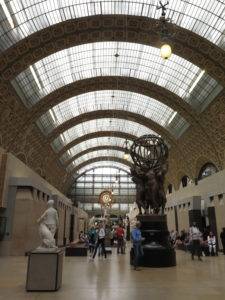
The museum holds mainly French art dating from 1848 to 1914 including paintings, sculptures, photography and even some furniture. Including some time stepping outside to find a bench for a short lunch break, we were there for nearly four hours. This really is a huge building and holds perhaps the very best and largest art collection in the city, especially of the impressionist painters. On any trip to Paris, do NOT miss a visit to the Musée d’Orsay.
After our museum visit, we walked west along the edge of the Left Bank, below the street, to buy some ice cream from Food Breizh.
Perhaps better known for all of their other organic food products, they also create their own organic ice cream. And it was definitely delicious!
We continued on to the beautiful, elaborately sculptured bridge Pont Alexandre III to cross back to the Right Bank. From here, you can see the Eiffel Tower and the Grand Palais, some of the most beautiful sights in the city.
Giverny, Maison et Jardins de Claude Monet
When planning a trip to see the house and gardens of Claude Monet in Giverny, it is definitely best to buy the 10.50€ tickets online a day or more ahead of time. You can print them yourself, or if you don’t have a printer available like us, you can pick them up at any fnac outlet. With advance tickets you can ignore the 1 to 2 hour lineup and walk straight in through the Advance Ticket and Group Entry.
You can reach Giverny from Paris by train for 14.70€ from the Gare St Lazare station. We rode on the 8:19AM train, choosing forward-facing seats upstairs on the right side for the best views, arriving in Vernon at 9:05. Right outside the station door you will have various shuttle services waiting to drive you the 20 minutes or so to Giverny. The main choice is a return ticket on the bus for 10€ or on the little train for 8€. We chose the train; not ONLY to save a couple euro, but also because it zig zags through the streets of Vernon first, with a recorded tour commentary in both French and English.
We arrived in the parking lot at Giverny right at the opening time of 9:30 and followed various directional signs to take you along paths to see a sculpture bust of Monet in the forest, through the little village of Giverny to Monet’s tomb next to his church, etc., and of course, a sign to direct you to his house and famous gardens. Their website gives you the details and history. And if you have ever enjoyed any of Monet’s paintings, you will probably recognize some of the scenes in my photos.
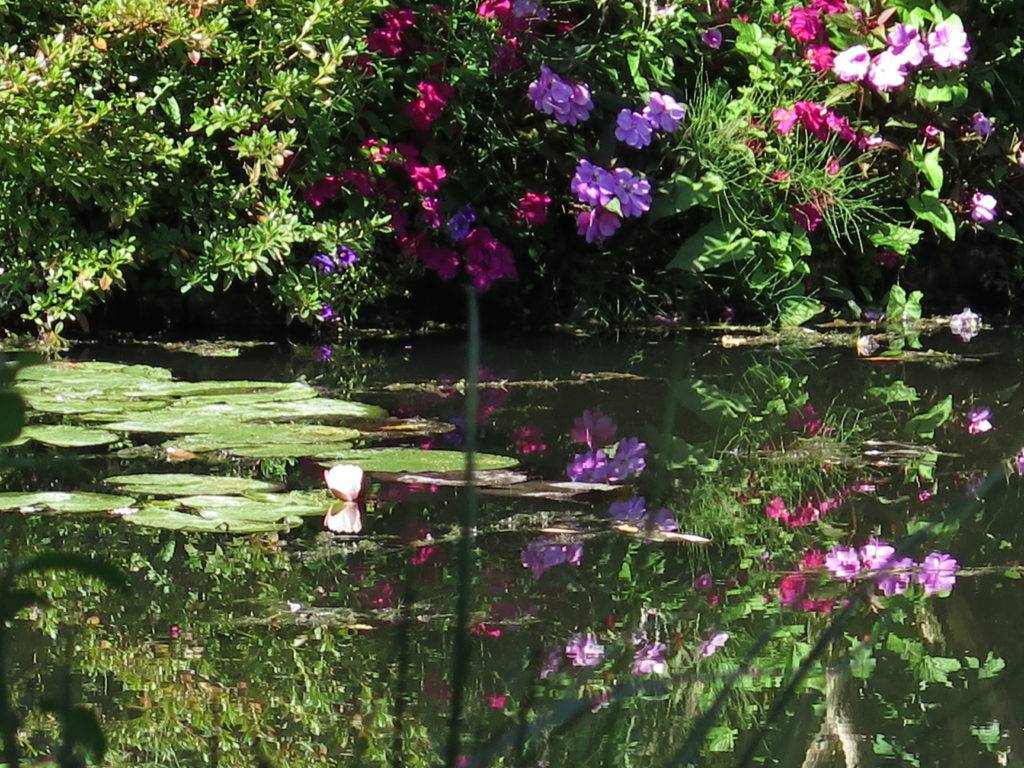
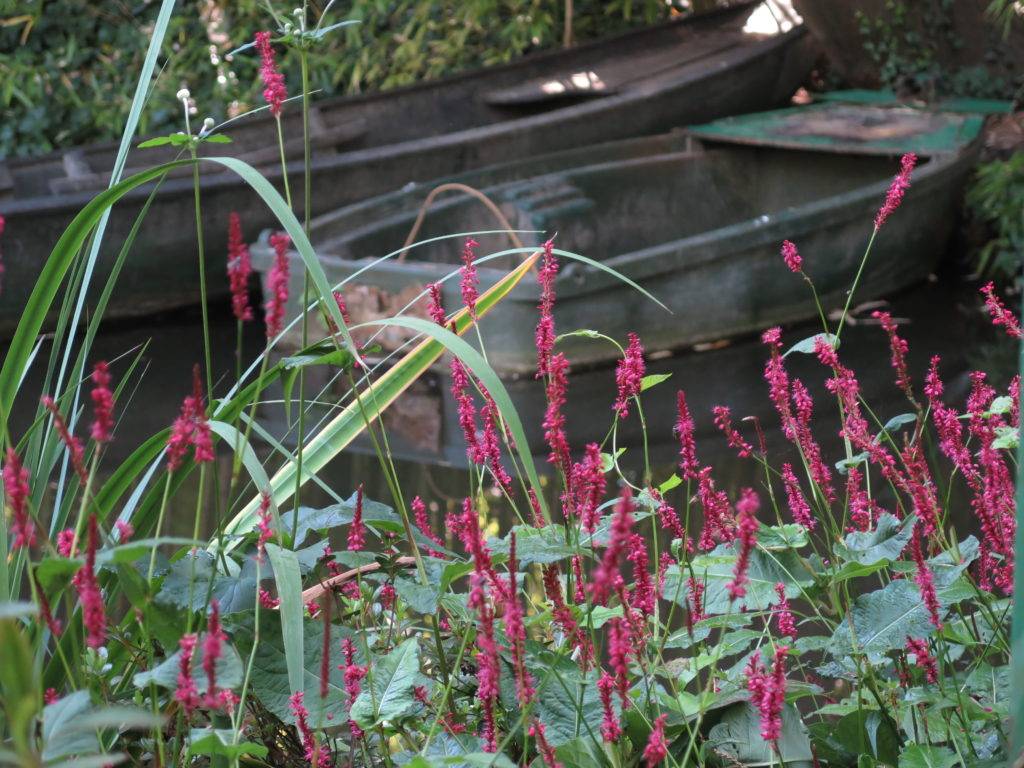
After a couple of hours in the gardens, they were filling up so much with tourists that it became nearly impossible to take any more photos. I HIGHLY recommend getting there right at opening time, not only for the photography but to better enjoy the serenity of the gardens.
We left the gardens finally to get into a 20 minute lineup to walk through his home and studios. They have filled the walls with replica paintings to try and match photos of the time. The house viewing ends in a huge studio area that he used for his famous giant Lilies paintings in the Musée de l’Orangerie, now being used as a gift shop. As usual, we ate our packed lunch and wine on one of the many benches throughout the village. There is no food allowed directly within the gardens. We took a walk through the village afterwards, where you will find a few outdoor restaurants and numerous galleries from a variety of present day impressionist painters. We also stopped in at his little church and saw his, and his family’s, tomb just on the right side of the church.
We met the little train back in the parking lot at 1:40PM and enjoyed another little tour of Vernon, different sights than on our way out, and were dropped at the station nearly an hour ahead of the next train to Paris Gare St Lazare at 2:53. After buying our tickets we walked outside to a little restaurant just a few feet away to enjoy an after-lunch café. The train was quite full going home but we managed to get forward-facing seats upstairs on the shady left side for nice views on our way back to Paris.
Eiffel Tower, and the Luxembourg Garden
On our first trip to Paris four years ago, I had probably posted close to 100 photos of the Eiffel Towerwithin the first few days here. The sight of it fascinated me! On this trip, although we had the occasional glimpse of the tower as we travelled around the city, we did not actually go down to see it for over two weeks!
There was a lot more security around the tower this year, as there is at all major monuments and museums in the city. because of that, there were huge lineups to get through a gate just to stand directly below the tower. And although I had considered buying a ticket to go up this year, it appeared to be a wait of 2 to 3 hours so we decided to pass on that attraction.
The Eiffel Tower was built by Gustave Eiffel for the 1889 Exposition Universelle. If you like, you can click above on the Eiffel Tower link for the history, facts, and tourist info such as the prices to go up the Tower, or you can just enjoy the few photos I’ve posted here.
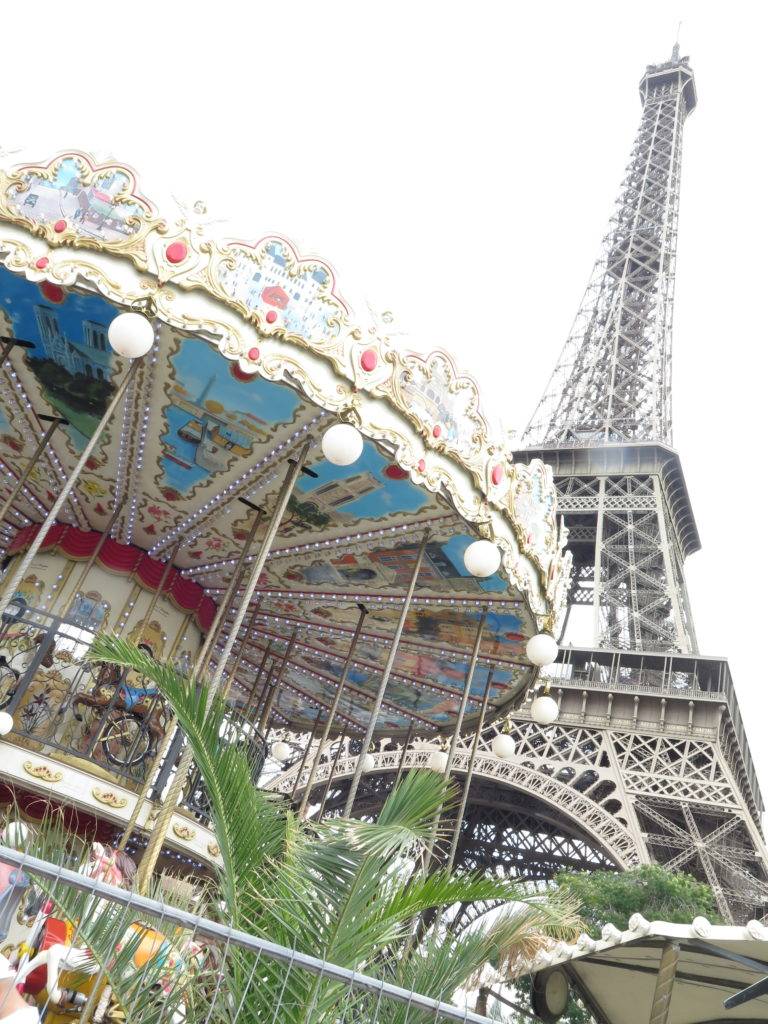
After wandering around the tower for a while, we decided to jump on the metro and make our way over to Le Jardiniere du Luxembourg. Located in the 6th arrondissement, it was created in 1612 by Marie de’Medici, the widow of King Henry lV of France, for a new residence she constructed, the Luxembourg Palace. You can click the link above for more details.
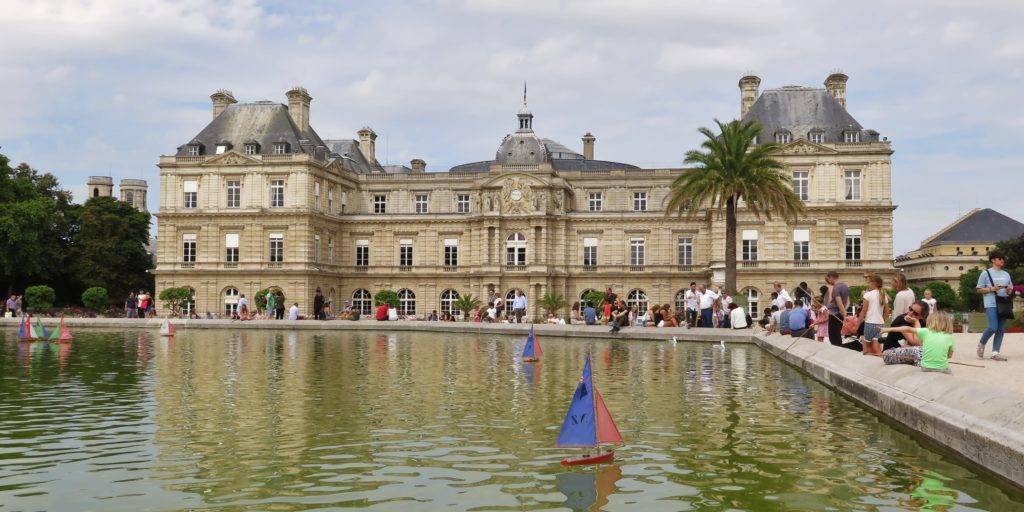
The gardens cover 25 hectares and are filled with lawns, flowers, trees, ponds and fountains and dozens of sculptures throughout. The Parisians and tourists love the tranquility here and visit for walks, jogs, picnics and to play with the remote control sailboats in the pond. It’s a great spot to buy an ice cream cone and relax on one of the hundreds of chairs set out by the water or in the shade.
Provins
The medieval town of Provins, was declared a UNESCO World Heritage site in 2001. Existing since the early Middle Ages, Provins was a wealthy commercial town. On the ancient lands of the Earls of Champagne, Provins is located on the crossroads of the European trade roads.
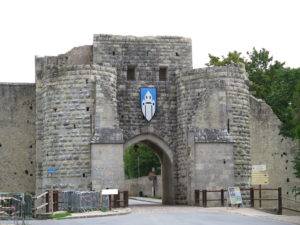
Although a busy tourist attraction, this is a real town, with citizens, schools, and regular businesses. Streets and walkways are rough and cobble-stoned, buildings are surrounded by high walls, gardens and huge old trees. Walking through the townsite really is like stepping back in time.
There are a lot of interesting things to explore here and our visit stretched into several hours. Our Metro Navigo Pass covered our SNCF Transilien train fare from Paris Gare de l’est to Provins, as well as a PROCARS small shuttle bus from the stops next to the train station for the 10-minute ride to the Tourism office at the gates to the old town. Tickets for specific times to attend various attractions must be bought in advance in the Tourism office, requiring some guessing as to how long you will take to wander through the many sites.
Even though our tour was only in French, we enjoyed our walk through the Underground Galleries. This is a maze of tunnels, originally used as a quarry, later becoming hiding places, storerooms and meeting places for various gatherings, such as the Freemasons.
Although recent upkeep is lacking a bit, we still enjoyed our walk through the Provins Rose garden. Three hectares of landscaped gardens, with 1,500 types of roses. There are a variety of lawn chairs, benches and small clearings throughout the gardens, providing inviting places to stop and relax, surrounded by the various scents of the flowers. We took advantage of one shaded bench to have our packed lunch.
The Caesar Tower is a castle-like structure from the 12th century, built to symbolize the counts of Champagne authority over the town and region. LOTS of narrow, rough, stone stairs gradually lead you through the structure, along parapets, and finally up into the bell tower. The 360 degree view over the town and across the countryside from here is well worth the climb.
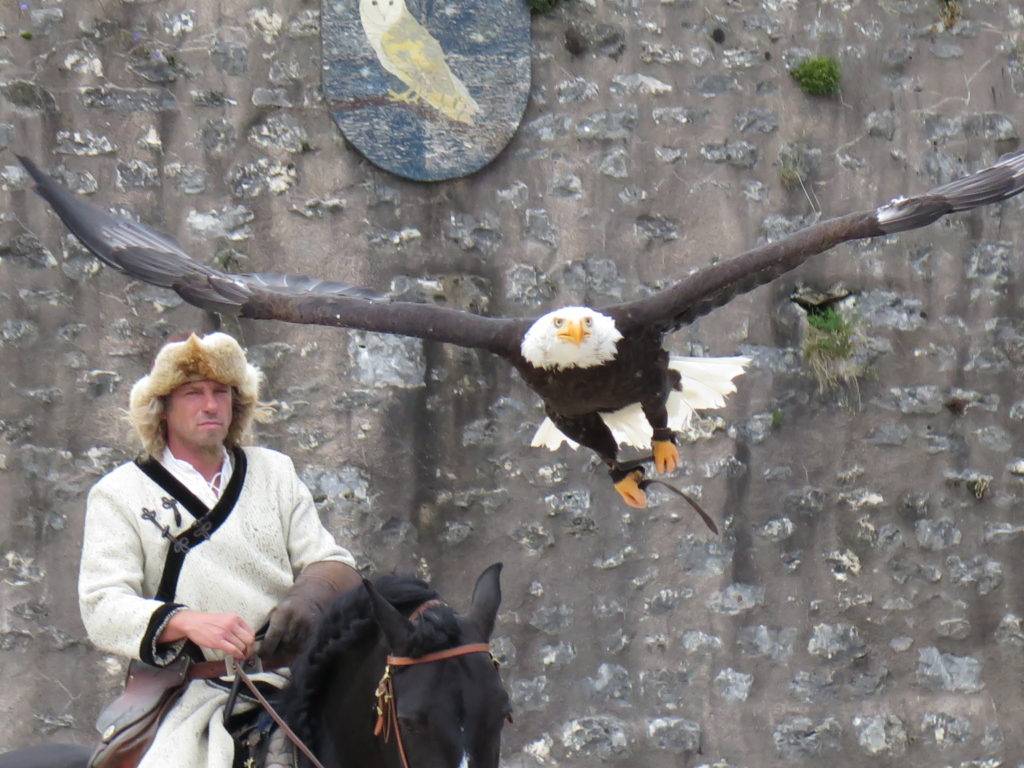
Fortified ramparts surrounded the entire town at one time, and we were able to walk along the top of some of them as we made our way back towards the gates to attend the Eagles of the Ramparts Equestrian Falconry show. The show begins with kind of a play of life in the Middle Ages and includes horses, a camel, donkey, wolves and of course LOTS of birds; bald eagles, hawks, falcons, vultures and owls, all flying over, around, and even THROUGH the crowd! This show was quite amazing, and scary at times when a falcon or bald eagle fly at high speed straight at your head and their wings brush your hair as they go by. After the show we toured through one of the greatest aviaries in France, with about 100 birds from 30 species.
The local museum fills three floors of a 13th century Romanesque House, the oldest stone building in the town. It holds a variety of art including medieval ceramics, paintings, goldsmith crafted religious objects, Greco-Roman statues, and Merovingian sarcophagi.
We stopped in at the Tithe Barn on our way out, which used to be kind of a covered market with a variety of merchants, money-changers, and artisans. It was set up like a museum with wax figurines and artifacts to reenact scenes of the day.
We were able to catch a bus from the stops at the Tourism office by the gates, back to the train station, then with only a short wait, back onto an SNCF train home to Paris.
Île du Levant
Along the Côte d’Azur, on the Mediterranean coast in the south of France, between Marseille and Nice, is the small city of la Lavandou; a beautiful, touristy beach community.
To reach here from Paris required a four hour train journey to Toulon, (at 108€ each way) then a 3€, one hour bus to la Lavandou. It’s about a 15 minute walk from the bus stop to the beach, docks and ferry terminal where for 28€ round-trip you can take the 45 minute voyage to the naturist island of Île du Levant .
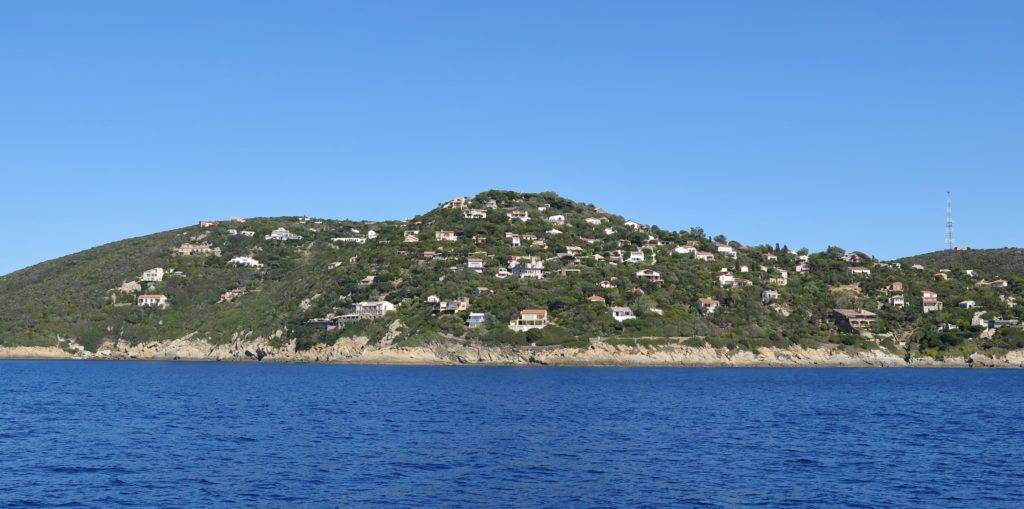
Luckily, I was able to choose a train, bus and ferry with tight connections, making our total trip under 7 hours, but at other times on other days, the trip may easily take 10 hours or more. Upon arrival, you can either make the tiring trek (if you have a suitcase,) up the little roads, stairs and walkways, uphill for 20 minutes or so, to reach whatever villa or room you may have rented. We chose to take a ride on the shuttle, one of the very few vehicles on the island. As we had no idea where our villa was located, it was much easier to let the driver find it for us. The cost is 5€ per person plus 4€ per bag. He dropped us off at a path which we followed along through the trees for a few minutes, then down some steps to another small path in the forest, until reaching our little villa with the most awesome panoramic view across the Mediterranean towards another island and the mainland.
The island mostly belongs to the French military and is fenced and off-limits. But the rest of it is a heavily treed, hilly island of nature reserve, hiking paths, private homes and small hotels and hostels, a small variety of restaurants and bars, a few shops for groceries or souvenirs, rocky coastline and beaches, all within the community of Héliopolis. And, the entire island is clothing optional. Except for the beaches and pathways along the ocean where no clothing is allowed, but, we saw occasional exceptions to that and nothing is enforced. It’s really all too relaxed and laid-back to worry too much about it.
This is NOT a nudist resort, but a family oriented naturist community. There are ALL types of people here, families with kids, couples and singles, young and old, fat and skinny, beautiful and, well, less so. And the all pervading atmosphere is very reminiscent of the 60’s, love and peace, easy-going warm friendliness.
The accessible island area is small enough that you can walk everywhere. With only about 84 full-time residents, even with a couple hundred tourists and part-time residents, there are definitely no crowds here.
Nude beaches are common enough around the world, but the first time you see nude people in the grocery store or walking into a restaurant, it seems a little strange. Probably nearly half the people when not on the beach usually wear something, but not much. And in most restaurants the majority of patrons are somewhat clothed, especially in the evening. Although in one rustic outdoor restaurant serving crepes, the prep girl next to the grill wore only a bit of a scarf for a skirt and worked topless, the male cook wore ONLY an apron, and at least half of the clients were nude. Some of them appeared to be locals, or regular visitors, who had not worn a stitch of clothing for the past few decades. The nudity all around you actually becomes very comfortable and natural very quickly and easily.
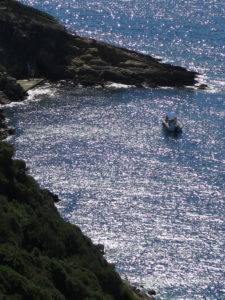
The island has good water but its not chlorinated so you must buy bottled drinking water at one of two small grocery stores or the bakery. Most shops and restaurants take credit cards but you will definitely need some cash, and as there are no bank machines on the island you need to bring the cash with you.
The restaurants are mostly open-air, with some indoor seating for poor weather. Obviously everything is VERY casual although we saw the occasional person dressed up for dinner. Most of the shops and restaurants close in the afternoon, only reopening some time between 7 and 8pm so dinner is late. Our little villa had a separate outdoor kitchen of sorts with a small fridge and two-burner cook-top. Although with only staying for 3 nights we decided to have lunch and dinner in the restaurants.
You can find accommodation through links on the island website, or through Air BNB or a variety of other rental websites. And be forewarned, the island is VERY popular so most rooms are booked up over a year in advance. Our small villa was rustic but comfortable, with wifi, good hot water, and as I mentioned, a bit of a kitchen, and lots of outdoor seating including a small dining table. I found it listed on Air BNB and it was exactly as shown. Our hostess Laurette spoke only French and was very nice and helpful and made sure that our stay was comfortable.
If you have ever wondered about this type of vacation, I would highly recommend Île du Levant. A very beautiful location, with an easy-going, comfortable atmosphere.
Saint Denis Basilica Cathedral –
Necropolis of the kings of France
40 minutes on two metro lines north of our home base in the 2nd arrondissement, is the district of St. Denis. We made the trip out here on Sunday to see the Saint Denis Basilica Cathedral and a necropolis, and the huge market nearby that is on every Tuesday, Friday and Sunday.
The market has hundreds of stalls across a large square and spilling out down the streets running off in every direction. Most of them are outdoors with clothing, shoes, luggage, lingerie, scarves, cell phones and electronics, a variety of produce and Moroccan ethnic foods. This is the sort of crowded, sketchy market where you do not keep anything in your pockets and you hold your bag close.
The indoor market was nearly as large with numerous butchers, bakeries, fish merchants, cheeses, and all types of produce. I bought a couple of big sausage rolls for a snack and Chris bought some kind of Moroccan corn meal and vegetable baked thing for her lunch, and another baked date-filled treat for dessert.
Across another large, open square from the market stands the St. Denis Basilica
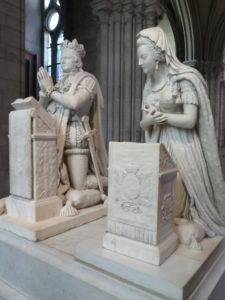
Cathedral. Originally built in the 5th century on the site of a Gallo-Roman cemetery, it became one of the most powerful Benedictine abbeys in the Middle Ages. Most of the kings and queens of France were buried here, in and under the Cathedral, from the 6th century onwards, including 42 kings, 32 queens, 63 princes and princesses, and 10 great men of the realm.
